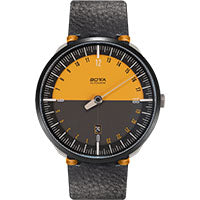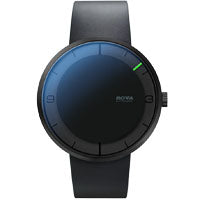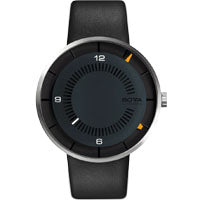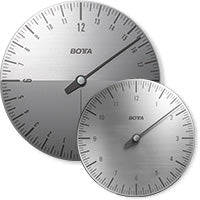Mechanical watch vs. quartz watch - Part 1: Watches with mechanical movement
Mechanical watch vs. quartz watch - Part 2: Watches with electric drive
In this 1st part of a two-part article you will find basic information about automatic and other mechanical watches - explained in an understandable way:
Rarely do opinions divide so clearly into two camps as on the subject of wristwatch drives.
The one nothing would come to the wrist, which does not have a mechanical movement. The other swears by the simplicity of a quartz watch.
Reason for me, to compare both systems once completely neutrally and objectively.
Advantages and disadvantages of hand-wound watches and automatic watches
The hand-wound watch or the automatic watch.
For all non-experts, a short explanation of the terms:
A hand-wound watch is the classic in the league of mechanical watches. With it, the watch spring is wound by turning the winding crown typically once a day.
The "time counting" and driving of the hands is done by moving mechanical components, such as gears, shafts, bearings, etc.
An automatic watch is a mechanical watch with an automatic winding mechanism. A rotating oscillating weight on the back of the movement converts the movement of the wearer into a winding movement for the mainspring movement. Otherwise, it is identical to a hand-wound watch and has essentially the same features.
Advantages and disadvantages of mechanical watches
Advantage 1: A mechanical watch does not require batteries and, accordingly, does not require battery replacement. It draws its motive power from the aforementioned mainspring movement, a wound hairspring. The "spring movement" is charged by winding the crown or via the automatic winding mechanism. Thus, a mechanical watch is always autonomous in terms of energy supply.
Advantage 2: (Very important for watch lovers!) A mechanical watch has a soul. Its movement is a true precision mechanical marvel. It is unbelievable what technology and precision is housed in such a small mechanism. The evolutionary development work that goes into such a miniaturized timekeeping machine is also often underestimated. Without countless patents and highly developed special materials, combined with decades of optimization, it would be difficult even today to realize such a movement from scratch. This is demonstrated time and again by replicas of successful movements, which never quite achieve the reliability of their proven predecessors. There are parallels here with engine construction in the automotive industry.
Advantage 3: A mechanical movement is fascinating - especially when you can watch it doing its high-precision work through a glass caseback. On the one hand, there are the fast-moving parts such as the balance and the escapement, but also all the other high-precision components that interlock with extreme precision and tirelessly go about their work in the smallest of spaces. Even I, as a designer and technician with a preference for clean lines, am impressed by a stylishly finished mechanical movement. Technical ornaments like "Geneva stripes" or a "perlage" in the right place can enhance a movement even more. Colored galvanized components or blued screws also have a particularly refined effect. Also strong red rubies in the bearing points set stylish color accents in this overall work of art.
The precision with which the individual components are manufactured and finished is generally impressive. Here we are in the world of micrometers (one thousandth of a millimeter). Hardly any technical device relies on such high precision as a mechanical watch.
Advantage 4: "A mechanical watch speaks well of its owner". Of course, it does not speak in the literal sense, but it has a pronounced symbolic value. Of course, the wristwatch is only one of many symbols with which we consciously or subconsciously surround ourselves, but it is a very important one (see also: What does a watch tell us about its wearer?)
A hand-wound or automatic watch naturally also has disadvantages (or special features)
Here are a few examples:
Disadvantage 1: You have to wind mechanical watches every day. This "disadvantage" does not apply to automatic watches that are worn and moved daily or spend their breaks on a watch winder. Normal hand-wound watches without an automatic drive do indeed have to be wound daily.
A watch enthusiast would say: "I can wind my watch every day", i.e. with our watch winder. For many watch owners, it is actually a very positive daily ritual to provide their mechanical watch with fresh energy by turning the crown a few times a day. Therefore, disadvantage no. 1 can also be seen as advantage no. 5 - depending on your perspective.
Disadvantage 2: A mechanical or automatic watch has to be reset every time it stops. And that happens in less than two days if it is not moved. But even here, connoisseurs would say that this small procedure only takes a few seconds, creates a personal relationship with your own timepiece and is fun.
Disadvantage 3: Mechanical watches are less accurate than quartz watches. This is also undoubtedly true. Even the most expensive automatic watch does not come close to the accuracy of a quartz watch. Very well-adjusted and maintained mechanical movements have a tolerance of -0 to +20 seconds/day. Far too inaccurate for precision fanatics, perfectly fine for watch enthusiasts. After all, there are other timepieces for very precise time.
Disadvantage 4: Mechanical watches need to be serviced from time to time. This is also true. About every 5 years, such a watch should undergo a technical service. Even if it has been worn little or not at all, but is now to be put back into service. Although modern synthetic watch oils no longer resinify like their mineral oil-based predecessors, they do evaporate over time. Together with the abrasion of the mechanical parts, this results in stubborn dirt that can only be removed by professional cleaning. A lack of oil in the bearings leads to dry running and thus to significantly increased wear.
A professional watch overhaul with the replacement of wearing parts (this costs €219 in our BOTTA service, for example) restores the movement to its original condition and thus preserves the value and accuracy of the watch.
An analogy can be drawn here with a car. This also needs a service from time to time in order to remain functional in the long term.
Disadvantage 5: Mechanical watches are more sensitive than quartz watches. This is also true. However, modern movements from renowned manufacturers such as the ETA 2824-2 or the ETA 2893-2 are surprisingly robust. This is mainly due to the ingenious shock protection systems such as Inkablock, which can withstand even heavy blows quite well.
There are considerable differences depending on the type of movement. In fact, the handcrafted movements are often much more sensitive than the high-quality series movements.
Disadvantage 6: Mechanical watches, and automatic watches in particular, are significantly taller than quartz watches. Here too, it is in the eye of the beholder whether this is seen as a disadvantage or an advantage. Some people prefer large, expressive watches, while others prefer flat, elegant watches.
Here, too, there are astonishing developments, such as the aforementioned ETA 2893-2, which, despite its automatic drive including rotor, manages with a height of only 3.7 mm (!). For comparison: an average quartz movement also has a height of 2.5 mm.
Depending on the movement used or the case design, an automatic watch can therefore also appear quite slim.
This is a brief overview of the advantages and disadvantages of mechanical watches. They have more character than quartz watches. This means that they require more "attention", for example they need to be wound regularly. For connoisseurs, however, this is a beloved ritual and therefore has positive connotations.
In the second part of the article entitled Mechanical watch vs. quartz watch - Part 2: Watches with electric drive, you will find interesting information about quartz watches, including their advantages and disadvantages.
Experience time anew!
Yours, Klaus Botta

Learn more about watch technology:
What is sapphire glass, and what does a high-quality anti-reflective coating do?











1 comment
Lieber Herr Botta,
vielen Dank für diesen schönen Artikel. Da ja die F.A.S. seit Kurzem immer schon samstags geliefert wird, hat man sonntags fast nichts mehr zu lesen. Gerade deshalb ist dieser Beitrag so erfrischend. An einer Stelle aber haben Sie ungenau recherchiert. Ihr “Nachteil 3” stimmt so nicht. Es gibt wesentlich ganggenauere Uhren als solche, die Abweichungen von -0/+20 Sekunden pro Tag haben…
Bspw. weicht die Defy Lab von Zenith nur höchstens +/-0,3 Sekunden pro Tag ab.
Viele Grüße aus Aachen
Johannes Brand